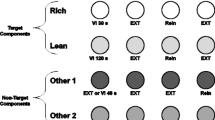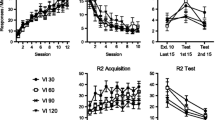Abstract
The role of the stimulus change accompanying food reinforcement, a potential conditioned reinforcer, in the development and maintenance of omission responding was examined in two omission paradigms. In the conventional response-terminated procedure a response during the trial stimulus immediately extinguishes the key light and initiates the intertrial interval (ITI), while in the standard fixed-trial procedure the trial stimulus terminates at the end of a fixed period of time irrespective of responding during the trial. A response during the trial stimulus in either procedure cancels the food reinforcement ordinarily available at the termination of the trial. In the present experiment, a particular key color was paired explicitly with food presentations on response-free trials. The conditioned reinforcing value of this stimulus was assessed in the fixed-trial and response-terminated procedures by presenting or withholding it at the end of trials containing a peck. The results suggest no critical role for conditioned reinforcement in the acquisition and maintenance of omission responding. For both procedures the rate of key peck acquisition, steady-state levels of responding, response latency and response rate were independent of the availability of conditioned reinforcement on food-omission trials. Moreover, the performances of subjects trained on the response-terminated procedure were no different from those of subjects exposed to the fixed-trial procedure.
Similar content being viewed by others
Reference Note
BALDOCK, M. 1974. Trial and intertribal interval durations in the acquisition of autoshaped key pecking. Paper presented at the meeting of the Eastern Psychological Association, Philadelphia.
References
BARRERA, F. J. 1974. Centrifugal selection of signal-directed pecking. Journal of the Experimental Analysis of Behavior, 22, 341–355.
BROWN, P., & JENKINS, H. 1968. Autoshaping of the pigeon’s key peck. Journal of the Experimental Analysis of Behavior, 11, 1–8.
GAMZU, E., & SCHWAM, E. 1974. Autoshaping and automaintenance of a key-press response in squirrel monkeys. Journal of the Experimental Analysis of Behavior, 21, 361–371.
GRICE, G. R. 1948. The relation of secondary reinforcement to delayed reward in visual discrimination learning. Journal of Experimental Psychology, 38, 1–16.
HEARST, E., & JENKINS, H. 1974. Sign tracking: The stimulus-reinforcer relation and directed action. Austin: The Psychonomic Society.
HERRNSTEIN, R., & LOVELAND, D. 1972. Food-avoidance in hungry pigeons, and other perplexities. Journal of the Experimental Analysis of Behavior, 18, 369–384.
HURSH, S., NAVARICK, D., & FANTINO, E. 1974. “Automaintenance”: The role of reinforcement. Journal of the Experimental Analysis of Behavior, 21, 117–124.
KELLEHER, R., & FRY, W. 1962. Stimulus functions in chained fixed-interval schedules. Journal of the Experimental Analysis of Behavior, 5, 167–173.
KELLEHER, R., & GOLLUB, L. 1962. A review of positive conditioned reinforcement. Journal of the Experimental Analysis of Behavior, 5, 543–597.
KLING, J. W., & SCHRIER, A. M. 1971. Positive reinforcement. In J. W. Kling & I. A. Riggs (Eds.), Woodworth and Schlosberg’s experimental psychology (3rd ed.). New York: Holt, Rinehart & Winston, Inc.
POWELL, R., & KELLY, W. 1976. Responding under positive and negative response contingencies in crows and pigeons. Journal of the Experimental Analysis of Behavior, 25, 219–225.
SCHWARTZ, B. 1972. The role of positive conditioned reinforcement in the maintenance of key pecking which prevents delivery of primary reinforcement. Psychonomic Science, 28, 277–278.
SCHWARTZ, B. 1973. Maintenance of key pecking by response-independent food presentation: The role of the modality of the signal for food. Journal of the Experimental Analysis of Behavior, 20, 17–22.
ASCHWARTZ, B., & GAMZU, E. In Press. Pavlovian control of operant behavior: An analysis of autoshaping and the interactions between multiple schedules of reinforcement. In W. K. Honig & J. E. R. Staddon (Eds.), Handbook of operant behavior. Englewood Cliffs, N. J.: Prentice-Hall.
SCHWARTZ, B., & WILLIAMS, D. 1972a. The role of the response-reinforcer contingency in negative automaintenance. Journal of the Experimental Analysis of Behavior, 17, 351–357.
SCHWARTZ, B., & WILLIAMS, D. 1972b. Two different kinds of key peck in the pigeon: Some properties of responses maintained by negative and positive response-reinforcer contingencies. Journal of the Experimental Analysis of Behavior, 18, 201–216.
SNAPPER, A., KNAPP, J., & KUSHNER, H. 1970. Mathematical description of schedules of reinforcement. In W. N. Schoenfeld (Ed.), The theory of reinforcement schedules. New York: Appleton-Century-Crofts.
STADDON, J. E. R., & SIMMELHAG, V. 1971. The superstition experiment: A reexamination of its implications for the principles of adaptive behavior. Psychological Review, 78, 3–43.
STIERS, M., & SILBERBERG, A. 1974. Lever-contact responses in rats: Automaintenance with and without a negative response-reinforcer dependency. Journal of the Experimental Analysis of Behavior, 22, 497–506.
TERRACE, H., GIBBON, J., FARRELL, L., & BALDOCK, M. 1975. Temporal factors influencing the acquisition and maintenance of an autoshaped response. Animal Learning and Behavior, 3, 53–62.
WESSELS, M. 1974. The effects of reinforcement upon the prepecking behaviors of pigeons in the autoshaping experiment. Journal of the Experimental Analysis of Behavior, 21, 125–144.
WILLIAMS, D., & WILLIAMS, H. 1969. Automaintenance in the pigeon: Sustained pecking despite contingent nonreinforcement. Journal of the Experimental Analysis of Behavior, 12, 511–520.
Author information
Authors and Affiliations
Additional information
This research was partially supported by a grant from the Faculty Research Fund, Western Michigan University. The study was conducted while the first author held a Graduate Fellowship sponsored by the Graduate School, Western Michigan University. Preparation of the manuscript was completed while the first author held an NIMH Predoctoral Fellowship (1F31 MH05993-01).
Rights and permissions
About this article
Cite this article
Petersen, M.R., Lyon, D.O., Stone, W. et al. The Role of Conditioned Reinforcement in the Acquisition and Maintenance of Omission Responding. Psychol Rec 27, 235–254 (1977). https://doi.org/10.1007/BF03394443
Published:
Issue Date:
DOI: https://doi.org/10.1007/BF03394443




